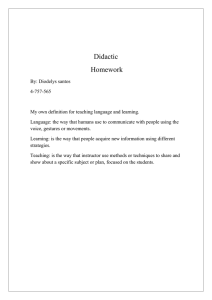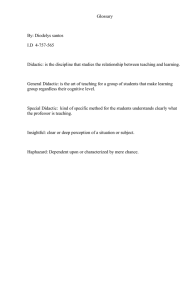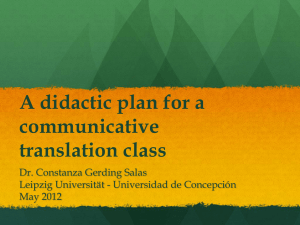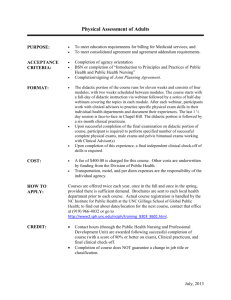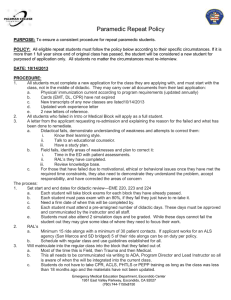DIDACTIC GUIDE OF GENDER EXPERTS – SUMMARY Module 1
advertisement
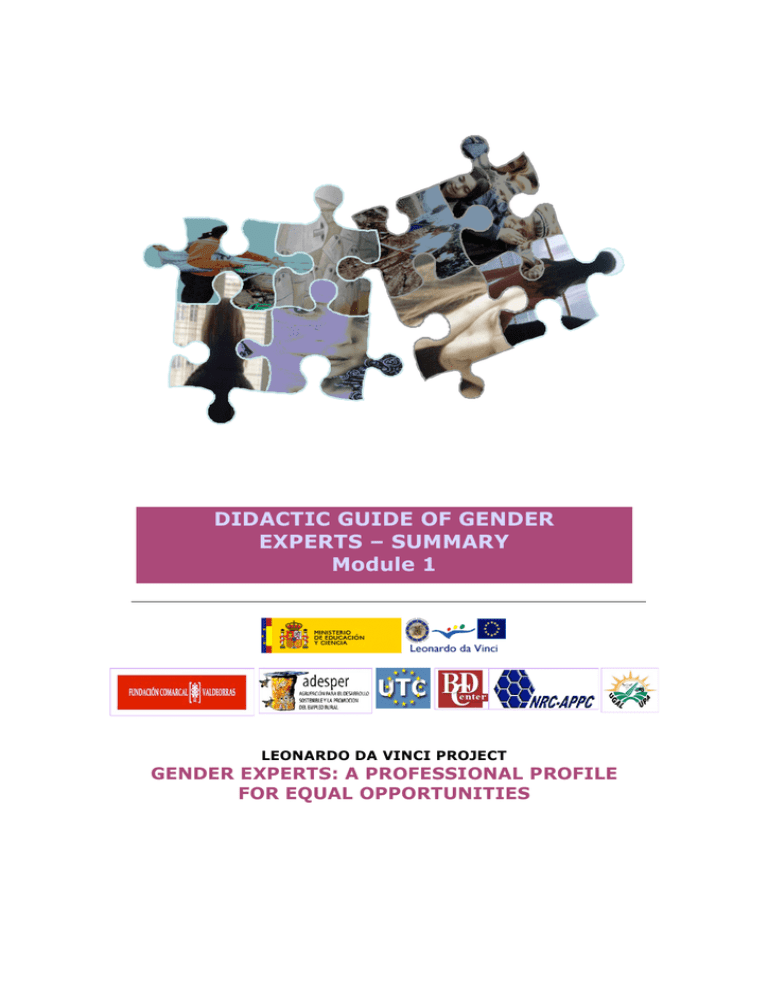
DIDACTIC GUIDE OF GENDER EXPERTS – SUMMARY Module 1 LEONARDO DA VINCI PROJECT GENDER EXPERTS: A PROFESSIONAL PROFILE FOR EQUAL OPPORTUNITIES MODULE 1 EQUAL CONCEPTS OPPORTUNITIES: HISTORY AND 1.- INTRODUCTION The equal opportunities must be understood from a social perspective and, therefore, in a specific context. Because of that this module is focused on giving the student an approach of the past, present and future of women’s situation, making the understanding of the current situation easier. In this process the feminist movements are especially important, due to the fact that they help women to turn into active figures in society, causing as much the development as the evolution. The equal opportunities is focused as much men as women, the only difference that there is between them is the fact that women have always been oppressed and men have always had their rights accepted. In this way, the concept of gender has special importance due to its meaning, that is, it is understood as social / cultural attribute and not as a simple biological difference. Due to that, the equal opportunities insists on balance such attributes, that is men and women must be represented equally in all social, labour, education, familiar contexts. The differences that do exist nowadays among men and women (see the case of Science and Technology) must be corrected and/or eradicated. Finally, other factor to be studied in the relations among men and women are the interpersonal relationships between both of them and that produce discrimination in the education, labour and family context. The main goal is to work in this first module with the things said above, that is the student will be able to understand concepts such as gender, women’s struggle…. As well as understand the different stages the women have been through throughout history, in order to be recognised, and to infer the meaning from those struggles. We will speak about these subjects and about much more in this module, which also has the following didactics units: MODULE 1 Equal Opportunities: History and Concepts 20 Hours Didactic Unit 1 The women’s struggle: periods and demands. Didactic Unit 2 Gender male and female, psycho – social aspects: stereotypes. Didactic unit 3 Gender and multiculturalism. Didactic unit 4 Gender, science and technology. Didactic unit 5 Gender and equal opportunities: new values in the interpersonal relationship for the equal opportunities. DIDACTIC GUIDE – SUMMARY. MODULE 1. 1 INDEX CARD 1 MODULE 1: EQUAL OPPORTUNITIES: HISTORY AND CONCEPTS 20 HOURS DIDACTIC UNIT 1 PRESENTATION AUTHORS OBJECTIVES CONCEPTS RESOURCES 4 hours THE WOMEN’S STRUGGLE: PERIODS AND DEMANDS This didactic unit approaches to the women’s struggle for the equal opportunities of men and women as a fundamental right for the development of society, what gives a better knowledge and understanding of the current situation, and the role of the feminism as driving the women’s role change in the development and evolution of society with numbers of demands. Raquel González Ferrón – Pedagogue • To identify the different stages of the feminist movement. • To understand the meaning of the struggle • To make a relation between the concept of struggle and the current equal opportunities policies. Feminism, feminist struggle, equal opportunities policies, pre – modern feminism, modern feminism, contemporary feminism and current feminism. Texts and documents concerning the subject and activities CONTENTS The feminism is a “movement made up by feminist women who are organized in different collective, platforms, assembly and women’s associations that have something in common that is the awareness of oppressed group by the patriarchal ideology. It has a social, politics, philosophic and demanding character that praise the equal rights of men and women and the freedom to choose the model of life that they want to lead, beyond the sex stereotypes and roles that determines behaviours, wishes and realities of men and women.” On the other hand the Suffrage is a women’s group of all social classes that share the claim of the right of the politics participation, one of the requirements was the vote, to reform the legislation, the custom and then society. It appeared in countries that adopted the capitalism with their ideal stated in the politic institutions. And the Patriarchy means “Parents’ government”, from the feminism is defined as a system of male domination on women. Because all of that the women had to struggle to have their rights recognised, and those struggles have been carried out in different stages: the pre-modern feminism, modern, contemporary and current feminism. Currently they are still struggling in different contexts. Cases analysis, discussion about the women’s situation having ACTIVITIES support in the women’s bill and concept definitions that support our learning. ASSESSMENT Initial Assessment: Questions Training assessment: Participation, carrying out and student’s involvement in the activities. Systematic observation. Final assessment: Open questions solution. • SOME BIBLIOGRAPHIC REFERENCES • • Franco Rubio, Gloria Angeles.” Siglo XX”, Historia Universal, Madrid, Historia 16. Duhet Paule Marie. (1974) ” Las mujeres y la revolución". Barcelona. Ed. Península. Gouges Olympe. (1789) “ Declaración de los derechos de la mujer y de la ciudadana”, para sé decretada por la Asamblea nacional francesa. DIDACTIC GUIDE – SUMMARY. MODULE 1. 2 INDEX CARD 2 MODULE 1: EQUAL OPPORTUNITIES: HISTORY AND CONCEPTS 20 HOURS DIDACTIC UNIT 2 PRESENTATION AUTHORS OBJECTIVES CONCEPTS RESOURCES GENDER MALE AND FEMALE AND PSYCHO-SOCIAL 4 hours ASPECTS: STEREOTYPES This didactic unit is an approach to the gender from a social and psychological perspective, trying to talk about gender as a social and cultural gift, not natural or biological, assuming this as the difference of what it is called sex. Delfina Mieville Manni – Sociologist Elisabeth Ortega Suárez – Psychologist • To identify the perspectives around the concept of gender • To make differences among the assumption of the theories involved in the process of gender construction. • To identify the stereotypes concerning the gender. Gender, anthropological and psychological perspective of gender, gender stereotypes, theories concerning the gender. Cards and markers. CONTENTS From the fact that men and women have different physical and behaviour features, the investigation, from the psychology to the gender anthropology, are based on the observation of basic biological mechanisms and how these influence in the development of the behaviour. During the first stages of socializing (firsts years in the bossom of the family and the nearest external world) is when the individual has a sex relation with the social reality. Actually we are not men nor women, we build ourselves as them. This construction is carried out in a process where biological aspects take place, but also, psycho-social ones. The stereotypes also influence, these are always negative, when they are considered strictly. The current diversity of the socializing agent makes the society dynamic. There are theories that have studied the gender roles: The social learning theory, the cognitive development theories and the socio-cognitive theory. This construction of the personal identity, is sometimes predetermined, for which the stereotypes that society pass help, not only in the family field, but also in the social and labour and those we must work to be eradicated. Outlines carrying out that support our learning, models making that ACTIVITIES are a evidence of the roles and stereotypes we are subjected to and analysis of concepts that favour our critic spirit. ASSESSMENT SOME BIBLIOGRAPHIC REFERENCES Initial assessment: Questions Training assessment: Participation, carrying out and student’s involvement in the activities. Systematic observation. Final assessment: Open questions solution. • • • • Paul Bahannan, “Para raros nosotros”, Akal 1992 “Mosaicos y Taraceas: “ Deconstrucción Feminista de los discursos de Género” Mercedes Bengoecha y Marisol Morales editoras, Universidad de Alcalá, 2000. Mercedes Bengoechea y Marisol Morales editoras, Universidad de Alcalá, 2000. DIDACTIC GUIDE – SUMMARY. MODULE 1. 3 INDEX CARD 3 MODULE 1: EQUAL OPPORTUNITIES: HISTORY AND CONCEPTS 20 HOURS DIDACTIC UNIT 3 PRESENTATION AUTHORS OBJECTIVES CONCEPTS RESOURCES GENDER AND MULTICULTURALISM 4 hours This didactic unit wants to give evidence about the current social reality, the multiculturalism. And about how this fact can influence in the perception and dimension of gender. Pilar Arias Aller – Social worker • To know investigation studies of the process of construction of culture identities from the gender perspective. • To understand the cultural, politics and social aspects of the gender dimension. • To design good manners of social integration. Multiculturalism, identity construction, gender dimensions, social integration, citizenship, social and politics minorities... Dictionaries, cards, markers, magazines, T.V, DVD, CONTENTS We understand as multiculturalism as a social phenomenon that gathers different human groups, but they live together in the same social space. This social phenomenon is linked to the social groups appearance, already known, but that are in the process of being recognised again: such as the native from America and women. These last ones have always been considered as a minority, above all because they have always been in the background, violated concerning their civil, social rights and always marginalized. The fact that to consider a society to be multicultural involves to accept the differences that distinguish it, and consequently to establish politics, social and economic measures, which would guarantee the social union. In this way the women must receive measures such as the positive discrimination, and all the possible politics recognitions. Only in this way, the women would be recognised as an active social agent, that is, they would be recognised the citizenship. In order to carry out that integration, the policies must respect the democratic society and keep in mind the women. That means, feminist policies implementation, and including women in the public places, giving them voice. ACTIVITIES ASSESSMENT Analysis of real cases, debates y practical exercises Initial assessment: Questions Training assessment: Participation, carrying out and student’s involvement in the activities. Systematic observation. Final assessment: Open questions solution. • BIBLIOGRAPHIC REFERENCES • • • Multiculturalismo, democracia paritaria y participación política. Rosa Cobo. Universidad de La Coruña. Publicado en POLÍTICA Y SOCIEDAD, Madrid, nº 32, 1999 “Mujeres en la aldea global” Suplemento especial El País, 2004. Enciclopedia Salvat www.mujeres.universia.es www.revelion,es DIDACTIC GUIDE – SUMMARY. MODULE 1. 4 INDEX CARD 4 MODULE 1: EQUAL OPPORTUNITIES: HISTORY AND CONCEPTS 20 HOURS DIDACTIC UNIT 4 PRESENTATION AUTHORS OBJECTIVES CONCEPTS RESOURCES GENDER, SCIENCE AND TECHNOLOGY 4 hours This didactic unit wants to approach the women’s evolution in the different scientists and technologic fields, the improvements achieved throughout the years and the positive actions to be carried out and that are being carried out to make the equality among men and women possible. Renata López Prada - ADESPER • To know the women’s trouble and its historic evolution in the scientist and technologic fields. • To promote the sensitizing measures to promote the change strategies. • To guide women in the development and change process with university education and professional options. Social participation, sensitizing measures and change strategies. Scientist magazines and published articles, scientist women biographies and Internet connection. CONTENTS Women are more and more present in the social, economic, politic life of any society. But, at the same time, it is also true that there are some aspects of the same life, see Science and Technology case, as well as high positions of power and decisions where the women has to climb up, as the percentage among men and women is still too unbalanced. The reasons for that discrimination can be found out in the following factors: the social models, the perception that the women may have about their own abilities and the professional option may be influenced by the social models (family background, teachers influence….). So we have that women is once more relegated to some professional positions that the tradition and society have considered as theirs. In this way, it is very important the women’s attitude, that is, complaining is not enough but they must act, more means, more struggle... For all of that, politics and social actions have been created with the aim of the women inclusion in decisions and important positions. ACTIVITIES Videogames analysis to have an evidence of discrimination. Ideas about why don’t women study science at university? and curricular documents analysis ASSESSMENT Initial assessment: Questions Training assessment: Participation, carrying out and student’s involvement in the activities. Systematic observation. Final assessment: Open questions solution. • BIBLIOGRAPHIC REFERENCES • • (2001,2003,2005) “Mujeres investigadoras del CSIC. www.csic.es (1996) Informe Mundial sobre la Ciencia. Editorial Santillana. Madrid. Women’s situation in the Education System of Science and Technology in Spain and their international context. By Eulalia Pérez Sedeño (Instituto de Filosofía-CSIC) DIDACTIC GUIDE – SUMMARY. MODULE 1. 5 INDEX CARD 5 MODULE 1: EQUAL OPPORTUNITIES: HISTORY AND CONCEPTS 20 HOURS DIDACTIC UNIT 5 GENDER AND EQUAL OPPORTUNITIES: NEW VALUES IN THE INTERPERSONAL RELATIONS FOR EQUAL OPPORTUNITIES PRESENTATION This didactic unit goes more deeply in the relations that exist among the male and female, in the education background, in the labour and family one, which treatment is different. AUTHORS OBJECTIVES Renata López Prada – ADESPER • • • CONCEPTS RESOURCES 4 hours To internalize the value concept. To assume the aspects that talk about the interpersonal relations. To go deep in the interpersonal relations features. Concept of value, interpersonal relations and violence of gender. Photocopies of the material, handbooks concerning the didactic unit and computers connected to Internet. Internet CONTENTS When we are living together we need to have models, values... to guarantee a harmony living that is shaping our identity as group and individual people. Those values are the equality, respect, and dialogue. The union of these three values in the interpersonal relations, would encourage the equality among men and women. This union of values would have several sceneries: Education: the values learnt from the school are the whole person. Labour: it is very important to insist on the integration and promotion of women, making the equality among men and women easier. Above all because women have work problems due to the inequality, due to that there are many programmes carried out to eradicate this problem (OPTIMA programme) and family: the family sometimes is a little equality model (authoritarian families, domestic violence…) Due to that, a education that promotes the respect and eradicates the gender roles, will promote the equal opportunities. ACTIVITIES Role Play: We will play situations where there are stereotyped interpersonal relations in the labour and family background. Equal Opportunities plans analysis to check impressions and results. Some cases analysis: we will choose companies and we’ll see the level of acceptance of labour market integration of women by men. ASSESSMENT Initial assessment: Questions Training assessment: Participation, carrying out and student’s involvement in the activities. Systematic observation. Final assessment: Open questions solution. DIDACTIC GUIDE – SUMMARY. MODULE 1. 6 • SOME BIBLIOGRAPHIC REFERENCES • • • • Diversity of gender in the interpersonal relations. Aurora Leal García. Universitat Autónoma de Barcelona. Departament de Psicología de l’Educació. 08193 Bellaterra (Barcelona). This work is part of a didactic material given to the primary teachers, where the school curriculum is studied from a co-teacher perspective. Women’s institute and Education Ministry. The authors are: M. Moreno, G. Sastre, M.D. Busquets, A. Leal y Xus de Miguel. Law 1/2004 of December 28th of measures of Integral protection against the gender violence in the Education Laws (LOGSE Y LOCE) Programme Óptima of the women’s institute. IV Equal opportunities National Plan (2003-2006). Comparative study of the Equal Opportunities Plans in the National and autonomous background, made by the Economic Studies General sub-department and Cooperation of the Women’s institute and published in January of 2005. DIDACTIC GUIDE – SUMMARY. MODULE 1. 7
